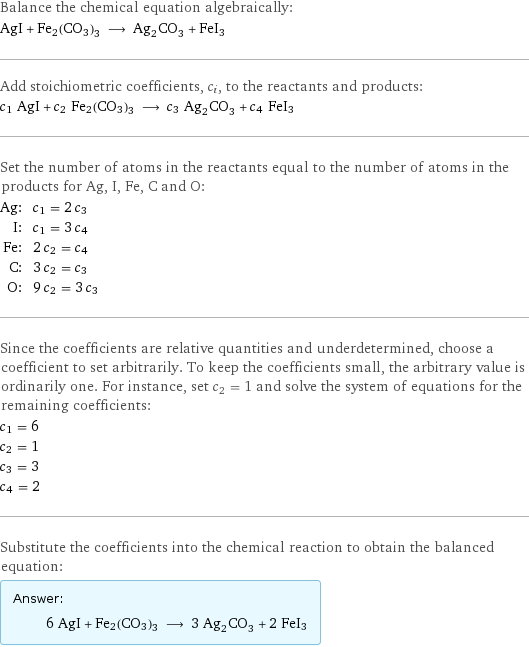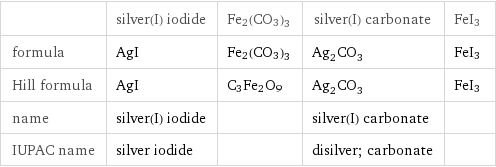Input interpretation

AgI silver(I) iodide + Fe2(CO3)3 ⟶ Ag_2CO_3 silver(I) carbonate + FeI3
Balanced equation

Balance the chemical equation algebraically: AgI + Fe2(CO3)3 ⟶ Ag_2CO_3 + FeI3 Add stoichiometric coefficients, c_i, to the reactants and products: c_1 AgI + c_2 Fe2(CO3)3 ⟶ c_3 Ag_2CO_3 + c_4 FeI3 Set the number of atoms in the reactants equal to the number of atoms in the products for Ag, I, Fe, C and O: Ag: | c_1 = 2 c_3 I: | c_1 = 3 c_4 Fe: | 2 c_2 = c_4 C: | 3 c_2 = c_3 O: | 9 c_2 = 3 c_3 Since the coefficients are relative quantities and underdetermined, choose a coefficient to set arbitrarily. To keep the coefficients small, the arbitrary value is ordinarily one. For instance, set c_2 = 1 and solve the system of equations for the remaining coefficients: c_1 = 6 c_2 = 1 c_3 = 3 c_4 = 2 Substitute the coefficients into the chemical reaction to obtain the balanced equation: Answer: | | 6 AgI + Fe2(CO3)3 ⟶ 3 Ag_2CO_3 + 2 FeI3
Structures

+ Fe2(CO3)3 ⟶ + FeI3
Names

silver(I) iodide + Fe2(CO3)3 ⟶ silver(I) carbonate + FeI3
Equilibrium constant
![Construct the equilibrium constant, K, expression for: AgI + Fe2(CO3)3 ⟶ Ag_2CO_3 + FeI3 Plan: • Balance the chemical equation. • Determine the stoichiometric numbers. • Assemble the activity expression for each chemical species. • Use the activity expressions to build the equilibrium constant expression. Write the balanced chemical equation: 6 AgI + Fe2(CO3)3 ⟶ 3 Ag_2CO_3 + 2 FeI3 Assign stoichiometric numbers, ν_i, using the stoichiometric coefficients, c_i, from the balanced chemical equation in the following manner: ν_i = -c_i for reactants and ν_i = c_i for products: chemical species | c_i | ν_i AgI | 6 | -6 Fe2(CO3)3 | 1 | -1 Ag_2CO_3 | 3 | 3 FeI3 | 2 | 2 Assemble the activity expressions accounting for the state of matter and ν_i: chemical species | c_i | ν_i | activity expression AgI | 6 | -6 | ([AgI])^(-6) Fe2(CO3)3 | 1 | -1 | ([Fe2(CO3)3])^(-1) Ag_2CO_3 | 3 | 3 | ([Ag2CO3])^3 FeI3 | 2 | 2 | ([FeI3])^2 The equilibrium constant symbol in the concentration basis is: K_c Mulitply the activity expressions to arrive at the K_c expression: Answer: | | K_c = ([AgI])^(-6) ([Fe2(CO3)3])^(-1) ([Ag2CO3])^3 ([FeI3])^2 = (([Ag2CO3])^3 ([FeI3])^2)/(([AgI])^6 [Fe2(CO3)3])](../image_source/9cb34bb23d322458379384037b70d024.png)
Construct the equilibrium constant, K, expression for: AgI + Fe2(CO3)3 ⟶ Ag_2CO_3 + FeI3 Plan: • Balance the chemical equation. • Determine the stoichiometric numbers. • Assemble the activity expression for each chemical species. • Use the activity expressions to build the equilibrium constant expression. Write the balanced chemical equation: 6 AgI + Fe2(CO3)3 ⟶ 3 Ag_2CO_3 + 2 FeI3 Assign stoichiometric numbers, ν_i, using the stoichiometric coefficients, c_i, from the balanced chemical equation in the following manner: ν_i = -c_i for reactants and ν_i = c_i for products: chemical species | c_i | ν_i AgI | 6 | -6 Fe2(CO3)3 | 1 | -1 Ag_2CO_3 | 3 | 3 FeI3 | 2 | 2 Assemble the activity expressions accounting for the state of matter and ν_i: chemical species | c_i | ν_i | activity expression AgI | 6 | -6 | ([AgI])^(-6) Fe2(CO3)3 | 1 | -1 | ([Fe2(CO3)3])^(-1) Ag_2CO_3 | 3 | 3 | ([Ag2CO3])^3 FeI3 | 2 | 2 | ([FeI3])^2 The equilibrium constant symbol in the concentration basis is: K_c Mulitply the activity expressions to arrive at the K_c expression: Answer: | | K_c = ([AgI])^(-6) ([Fe2(CO3)3])^(-1) ([Ag2CO3])^3 ([FeI3])^2 = (([Ag2CO3])^3 ([FeI3])^2)/(([AgI])^6 [Fe2(CO3)3])
Rate of reaction
![Construct the rate of reaction expression for: AgI + Fe2(CO3)3 ⟶ Ag_2CO_3 + FeI3 Plan: • Balance the chemical equation. • Determine the stoichiometric numbers. • Assemble the rate term for each chemical species. • Write the rate of reaction expression. Write the balanced chemical equation: 6 AgI + Fe2(CO3)3 ⟶ 3 Ag_2CO_3 + 2 FeI3 Assign stoichiometric numbers, ν_i, using the stoichiometric coefficients, c_i, from the balanced chemical equation in the following manner: ν_i = -c_i for reactants and ν_i = c_i for products: chemical species | c_i | ν_i AgI | 6 | -6 Fe2(CO3)3 | 1 | -1 Ag_2CO_3 | 3 | 3 FeI3 | 2 | 2 The rate term for each chemical species, B_i, is 1/ν_i(Δ[B_i])/(Δt) where [B_i] is the amount concentration and t is time: chemical species | c_i | ν_i | rate term AgI | 6 | -6 | -1/6 (Δ[AgI])/(Δt) Fe2(CO3)3 | 1 | -1 | -(Δ[Fe2(CO3)3])/(Δt) Ag_2CO_3 | 3 | 3 | 1/3 (Δ[Ag2CO3])/(Δt) FeI3 | 2 | 2 | 1/2 (Δ[FeI3])/(Δt) (for infinitesimal rate of change, replace Δ with d) Set the rate terms equal to each other to arrive at the rate expression: Answer: | | rate = -1/6 (Δ[AgI])/(Δt) = -(Δ[Fe2(CO3)3])/(Δt) = 1/3 (Δ[Ag2CO3])/(Δt) = 1/2 (Δ[FeI3])/(Δt) (assuming constant volume and no accumulation of intermediates or side products)](../image_source/b378347cd5b59ff53bd1798ee1160e8f.png)
Construct the rate of reaction expression for: AgI + Fe2(CO3)3 ⟶ Ag_2CO_3 + FeI3 Plan: • Balance the chemical equation. • Determine the stoichiometric numbers. • Assemble the rate term for each chemical species. • Write the rate of reaction expression. Write the balanced chemical equation: 6 AgI + Fe2(CO3)3 ⟶ 3 Ag_2CO_3 + 2 FeI3 Assign stoichiometric numbers, ν_i, using the stoichiometric coefficients, c_i, from the balanced chemical equation in the following manner: ν_i = -c_i for reactants and ν_i = c_i for products: chemical species | c_i | ν_i AgI | 6 | -6 Fe2(CO3)3 | 1 | -1 Ag_2CO_3 | 3 | 3 FeI3 | 2 | 2 The rate term for each chemical species, B_i, is 1/ν_i(Δ[B_i])/(Δt) where [B_i] is the amount concentration and t is time: chemical species | c_i | ν_i | rate term AgI | 6 | -6 | -1/6 (Δ[AgI])/(Δt) Fe2(CO3)3 | 1 | -1 | -(Δ[Fe2(CO3)3])/(Δt) Ag_2CO_3 | 3 | 3 | 1/3 (Δ[Ag2CO3])/(Δt) FeI3 | 2 | 2 | 1/2 (Δ[FeI3])/(Δt) (for infinitesimal rate of change, replace Δ with d) Set the rate terms equal to each other to arrive at the rate expression: Answer: | | rate = -1/6 (Δ[AgI])/(Δt) = -(Δ[Fe2(CO3)3])/(Δt) = 1/3 (Δ[Ag2CO3])/(Δt) = 1/2 (Δ[FeI3])/(Δt) (assuming constant volume and no accumulation of intermediates or side products)
Chemical names and formulas

| silver(I) iodide | Fe2(CO3)3 | silver(I) carbonate | FeI3 formula | AgI | Fe2(CO3)3 | Ag_2CO_3 | FeI3 Hill formula | AgI | C3Fe2O9 | Ag_2CO_3 | FeI3 name | silver(I) iodide | | silver(I) carbonate | IUPAC name | silver iodide | | disilver; carbonate |
Substance properties

| silver(I) iodide | Fe2(CO3)3 | silver(I) carbonate | FeI3 molar mass | 234.7727 g/mol | 291.71 g/mol | 275.744 g/mol | 436.558 g/mol phase | solid (at STP) | | solid (at STP) | melting point | 557 °C | | 210 °C | boiling point | 1506 °C | | | density | 5.68 g/cm^3 | | 6.08 g/cm^3 | solubility in water | slightly soluble | | insoluble |
Units
